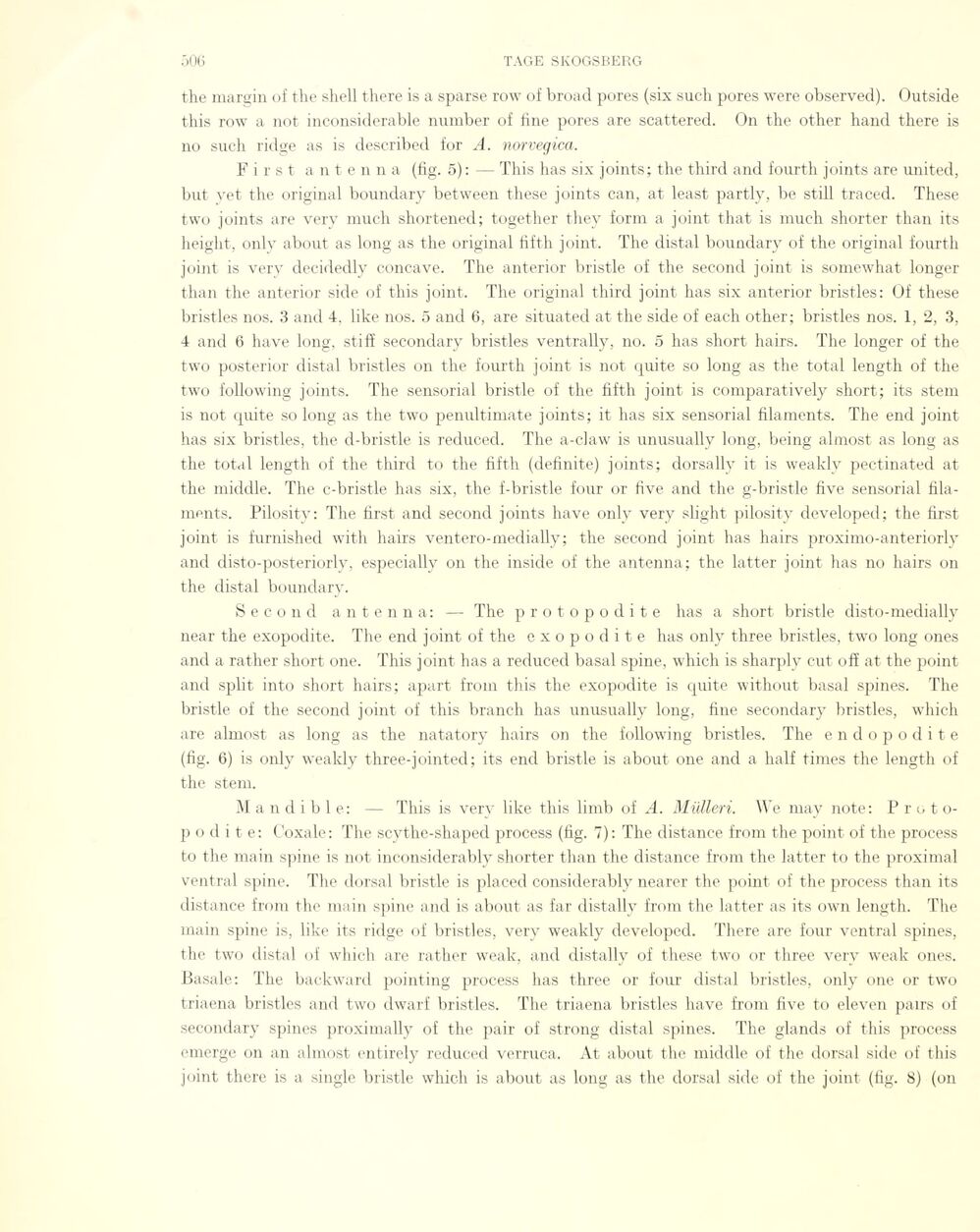
Full resolution (JPEG) - On this page / på denna sida - Sidor ...

<< prev. page << föreg. sida << >> nästa sida >> next page >>
Below is the raw OCR text
from the above scanned image.
Do you see an error? Proofread the page now!
Här nedan syns maskintolkade texten från faksimilbilden ovan.
Ser du något fel? Korrekturläs sidan nu!
This page has never been proofread. / Denna sida har aldrig korrekturlästs.
the margin of the shell there is a sparse row of broad pores (six such pores were observed). Outside
this row a not inconsiderable number of fine pores are scattered. On the other hand there is
no such ridge as is described for A. norvegica.
First antenna (fig. 5) : — This has six joints; the third and fourth joints are united,
but yet the original boundary between these joints can, at least partly, be still traced. These
two joints are very much shortened; together tliey form a joint that is much shorter than its
height, only about as long as the original fifth joint. The distal boundary of the original fourth
joint is very clecidedly concave. The anterior bristle of the second joint is somewhat longer
than the anterior side of this joint. The original third joint has six anterior bristles: Of these
bristles nos. 3 and 4, like nos. 5 and 6, are situated at the side of each other; bristles nos. 1, 2, 3,
4 and 6 have long, stiff secondary bristles ventrally, no. 5 has short hairs. The longer of the
two posterior distal bristles on the fourth joint is not quite so long as the total length of the
two folio wing joints. The sensorial bristle of the fifth joint is comparatively short; its stem
is not quite so long as the two penultimate joints; it has six sensorial filaments. The end joint
has six bristles, the d-bristle is reduced. The a-claw is unusually long, being almost as long as
the total length of the third to the fifth (definite) joints; dorsallv it is weakly pectinated at
the middle. The c-bristle has six, the f-bristle four or five and the g-bristle five sensorial
filaments. Pilosity: The first and second joints have only very slight pilosity developed; the first
joint is furnishecl with hairs ventero-medially; the second joint has hairs proximo-anteriorly
and disto-posteriorly, especially on the inside of the antenna; the latter joint has no hairs on
the distal boundary.
Second antenna: — The protopodite has a short bristle disto-medially
near the exopodite. The end joint of the exopodite has only three bristles, two long ones
and a rather short one. This joint has a reduced basal spine, w li ich is sharply cut off at the point
and split into short hairs; apart from this the exopodite is quite without basal spines. The
bristle of the second joint of this brauch has unusually long, fine secondary bristles, which
are almost as long as the natatory hairs on the following bristles. The endop odite
(fig. 6) is only weakly three-jointed; its end bristle is about one and a half times the length of
the stem.
Mandible: — This is very like this limb of A. Müllevi. We may note: P r o t
o-p o d i t e: Coxale: The scythe-shaped process (fig. 7): The distance from the point of the process
to the main spine is not inconsiderably shorter than the distance from the latter to the proximal
ventral spine. The dorsal bristle is placed considerably nearer the point of the process than its
distance from the main spine and is about as far distally from the latter as its own length. The
main spine is, like its ridge of bristles, very weakly developed. There are four ventral spines,
the two distal of which are rather weak, and distally of these two or three very weak ones.
Basale: The backward pointing process has three or fom’ distal bristles, only one or two
triaena bristles and two dwarf bristles. The triaena bristles have from five to eleven pans of
secondary spines proximally of the pair of strong distal spines. The glands of this process
emerge on an almost entirely reduced verruca. At about the middle of the dorsal side of this
joint there is a single bristle which is about as long as the dorsal side of the joint (tig. 8) (on
<< prev. page << föreg. sida << >> nästa sida >> next page >>